All we know and assume about the dumped mail ballots
07.07.2022

Zoltán Sipos
A mysterious, cautious source carefully deleting his digital tracks informed the press about mail ballots having been thrown out near Târgu Mureş. The deeper we dug, the fishier the story became.
At the end of the campaign for the Hungarian parliamentary elections, in the evening of the 31st March several journalists in Transylvania and people close to the Hungarian opposition received pictures of a plastic bag containing some wrinkled and partially burnt ballot papers lying on an illegal dumping site near Târgu Mureş.
After checking the veracity of the information, we reported about the ballots as well. The news spread like wildfire, and that very day every political side built its own narrative on it.
According to the Hungarian opposition, the dumped ballots were evidence of systemic fraud during the voting process aboard. Fidesz and the related organisations including the DAHR and the HNCT spoke about deliberate political provocation.
The case won’t be investigated
We will never know which narrative is closer to the truth as the National Electoral Office and later the Supreme Court rejected the investigation of the case. They reasoned that the election law was applicable only on Hungarian territory.
“(…) the deed did not happen in Hungary and consequently it cannot possibly investigate the activity of unknown individuals on the territory of Romania, for lack of jurisdiction” – the reasoning read.
We have learnt from unofficial police sources that the Romanian authorities are still investigating the case. We have no information as to whether they have been contacted by the Hungarian authorities. As the disposed papers were the ballots for the Hungarian elections, the question is whether the case could be prosecuted under Romanian law.
Nevertheless, there are many other pending questions. We tried to find out who the source taking the photos was, and the deeper we dug, the more suspicious the story became. Below we have collected the most important unanswered questions that can be set out based on the little information available.
What exactly did we see?
The bag and its contents are in the possession of the Romanian authorities. We only have a few photos and a video taken on site, as well as an eyewitness’ account. Based on them, all we can put together is that there were about a dozen ballots and slightly more reply envelopes (inner and outer envelopes) in the transparent plastic bag (which an eyewitness talking to Átlátszó Erdély compared to a simple household garbage bag).
Some of the ballots were filled out (in favour of opposition parties), and the margins of the ballots were singed. According to the eyewitness, there were some inches of ash in the bag. Declarations of identification (the documents that reveal the voters’ names and contact information) could not be identified in the pictures taken of the pile of documents. It was not possible to determine from the images whether the ballots were original or not.
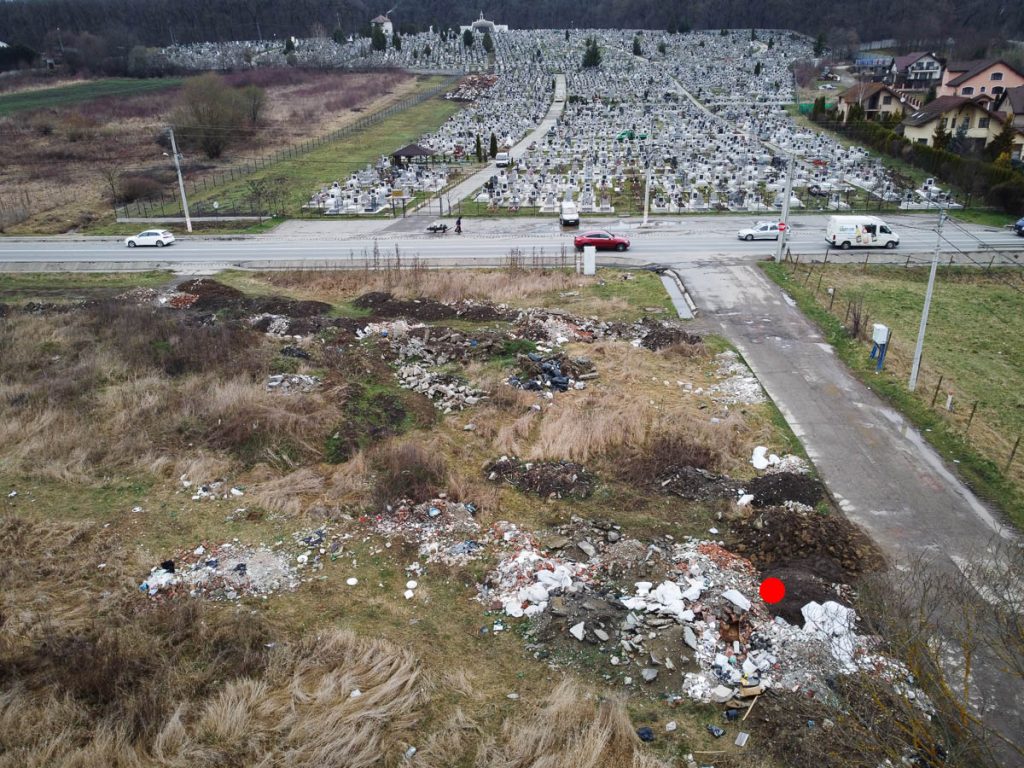
There is no evidence that the ballot papers and envelopes were burnt on the site. In the photos, the thin plastic garbage bag is intact, and didn’t melt. All signs show that the ballot papers were set on fire somewhere else, the ash and the partially burned ballots were placed in the plastic bag, and then the bag was disposed among the construction debris.
Are these really traces of voter fraud?
According to an obvious and virally spread explanation, these ballots are evidence of voter fraud during the postal voting process: some individuals directly interested in the victory of Fidesz deliberately destroyed the envelopes containing some votes in favour of the opposition, replacing them with envelopes containing the “right” votes.
A source of ours volunteering in the collection of mail ballots said that the mail ballots were transported by car from Târgu Mureş to the Consulate General in Miercurea Ciuc. (The road where the bag was found is on the route between Târgu Mureş and Miercurea Ciuc.) The envelopes were opened one by one, and the ballot papers replaced. In the following, we shall prove why this assumption is unrealistic.
How could it have been done? The basic condition would be that the offenders would have needed to know which envelopes contained votes for the opposition. If the envelopes (outer and inner) had not been sealed, that could have been easy to find out.
However, if they were sealed – and the majority of envelopes were probably sealed – it is not clear how the “problematic” votes could have been sorted out without opening all the envelopes. Given that Fidesz received 94% of all postal votes, every twentieth envelope could have contained votes cast in favour of the opposition. Opening all the envelopes could have been obviously much more costly (all votes would have had to be put in a new envelope) than profitable.
Let’s suppose that the ballots cast for the opposition could have somehow been identified. In this case, if the offenders had blank, unfilled ballot packages, they could have filled in the blank ballot papers, put the identification sheets from the “problematic” envelopes in the envelopes, and then sealed the envelopes and turned them in at the consulate. If this really happened, we get the explanation why there were no identification declarations found on the site.
In our opinion, electoral fraud cannot be completely ruled out, as technically it is possible. However, it is unlikely that a larger-scale electoral fraud was committed using this method.
Were the ballot papers really dumped among the debris for everyone to see?
The press reports said that the bag containing the ballot papers was found by a busy road that leads from Târgu Mureş to the neighbouring Livezeni village. This gives the impression that the ballot papers virtually lay before everyone’s eyes.
We have visited the site several times, and in our experience, this requires some qualification: the road to Livezeni is really busy, but mostly cars use it. It is possible to stop and park in front of the cemetery across the street (and probably the people who go to the cemetery stop here most often).
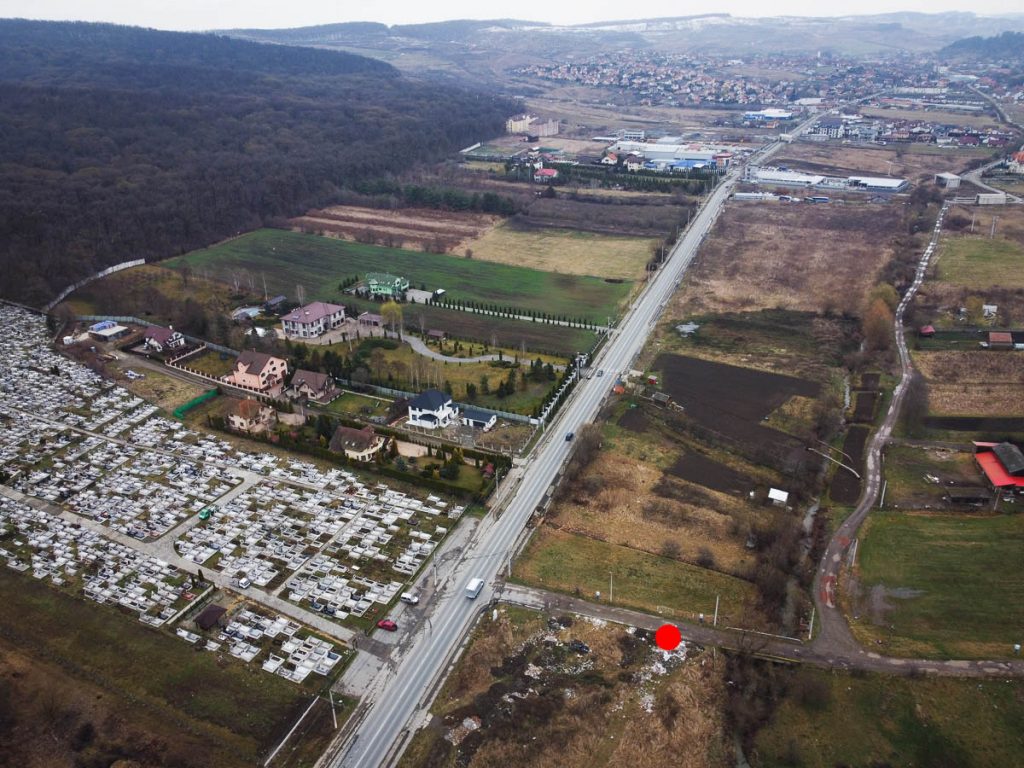
Although there is a narrow sidewalk, pedestrians are rare on this stretch of road. It is also important to note that there is a side road that leads to the construction debris dump, located at about 45-50 meters from the main road.
The bag in question was lying at about 2-3 meters from this side road, next to several other bags (full of construction debris). It might have been possible to notice from the road that there were documents in the bag, but this would have required a very careful examination of the site.
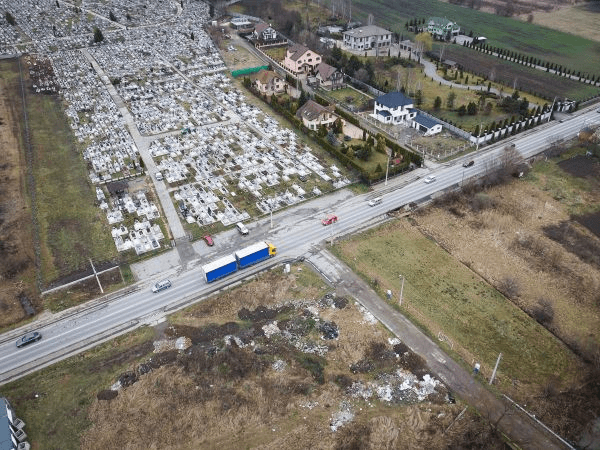
In light of this, it is highly difficult to imagine the scenario that a person walking around in the neighbourhood accidentally found the bag.
Who found the ballots?
As revealed above, the bag containing the ballots was placed in a busy yet outlying spot where the likelihood of unsuspecting passers-by accidentally finding it was very small.
It’s also important to note that the ballots could have been easily destroyed, so that no one would ever find them. For instance, the ballots could have been totally burnt.
Against this background, we assume that the aim was precisely to have someone discover the bag. Moreover, the one discovering the ballots was either an eyewitness on the spot where the bag was dumped or he threw the bag on the debris pile himself.
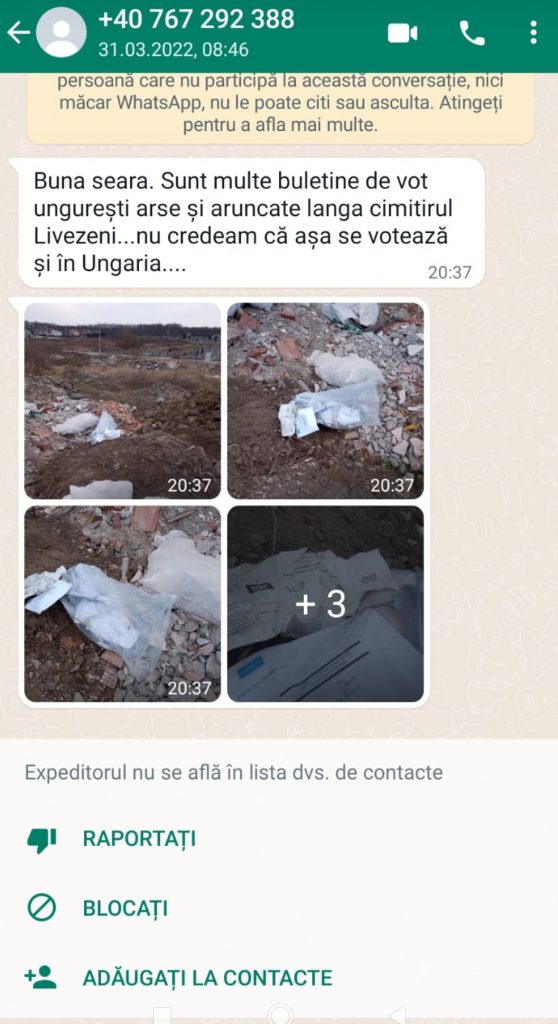
Whoever discovered it knew what he was doing. The contact details of the journalists and editorial offices in Mures County are not confidential, however this kind of information is not readily available to anyone, as a certain kind of skilfulness in public affairs is required to acquire them.
The source sent the first photos to several journalists around Mures County on the 30th March at 20:46 by WhatsApp. Two minutes later, a journalist working with the local TV channel (who asked us not to mention his name, as she didn’t deal with public affairs stories) forwarded this very first WhatsApp message to the Grup Presa IPJ Ms group. This group has 97 members: journalists and the representatives of Mures County Police Headquarters.
The WhatsApp number that the first message had initially been sent from was alive at the beginning. Cristian Teodorescu, the first journalist who arrived on site and to whom the source sent the pictures directly revealed that he had exchanged messages with the source at the beginning for around 10-15 minutes while he had been looking for the bag on the site. The last exchange of messages took place at 21:17, then the source could no longer be reached – Teodorescu said.
We also called the number in vain; we got the message that the number is no longer in use / the number cannot be reached. We also searched for the number in various databases, to no effect.
When taking the photos, the source also took care that journalists looking for the bag would not be groping in the dark. The cemetery is clearly visible in the first photo, so the exact location can be easily found by someone who more or less knows the area, and can also be identified very quickly on Google Maps.
The source was cautious as he sent the photos to the press by WhatsApp. This app automatically removes the metadata from the photos, which might have taken us one step closer to solving the mystery.
Who scattered the ballots around from the bag?
It can be seen that the photos attached to the first message were taken in sunlight. As on the 30th March the sun set at 19:53, we assume that the photos had not been taken right before being sent but at least an hour before or even earlier. It’s also striking that most of the ballot papers were in the bag, perhaps with two ballot papers or envelopes lying next to the bag.
To our knowledge, Cristian Teodorescu, the punctul.ro journalist was the first who got on site; he reported that this footage was recorded at 22:30. The recording clearly shows that the ballots were no longer in the bag here, but scattered around on the ground.
Teodorescu declared to Átlátszó Erdély that he had gone on site together with a close friend whom he had taken along to witness that he had not touched the bag. There was no one else on the site but them; they also left after 10-15 minutes. “I also realised later on that the first photos and the de facto situation (i.e. the scattered ballots) were different.” – he told us. For that matter, punctul.ro published the first report on it the following morning at 4:00, sharing it on Facebook at 7:00 AM.

How did the Hungarian opposition learn about the dumped ballots?
About half an hour after the photos got to the journalists of Mureş County, at 21:20 we also received photos of the bag lying on the dump from a source close to the Hungarian opposition. As far as we could tell, these were the same photos that had also been sent to punctul.ro: the direction of the lights as well as the position of the photographer and the bag were the same.

Tamás Bodoky, the editor-in-chief of atlatszo.hu, also received the photos from a Hungarian opposition background source shortly after, at 21:48. The photos might also have been sent to others.
The Hungarian opposition learning about the photos so quickly is interesting because, to our knowledge, the journalists of Mureş County, mostly of Romanian nationality, do not have a lot of connections among the Hungarian opposition parties and politicians.
How did Boróka Parászka get in the picture and how did the affair become a “leftist provocation”?
The Târgu Mureş Radio staff member and well-known publicist, went on site the next morning after learning about what had happened in the press (she claimed she hadn’t received the WhatsApp message). Parászka does not live far from the site (her house is 1.5 km as the crow flies from the cemetery, 2 km on the road). The publicist reported that the police had already been there when she arrived, and the investigators spoke Hungarian. Everyone was ID’ed but the reporter was not allowed close to the bag.
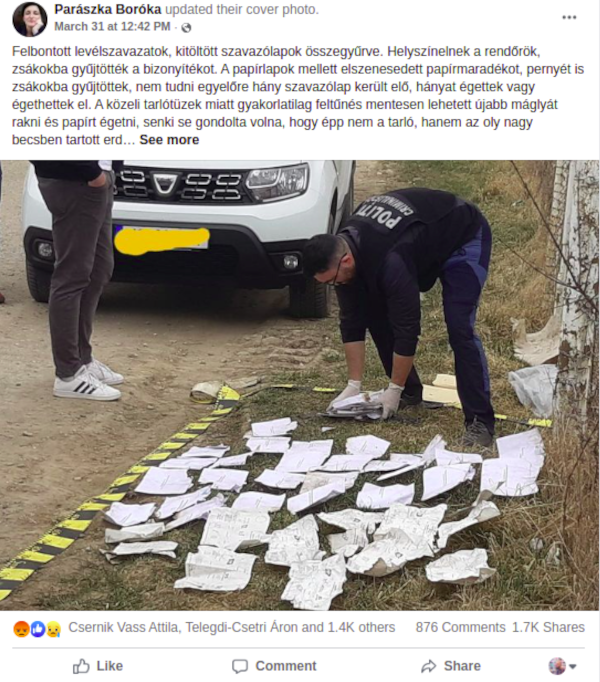
A photo of Boróka Parászka was taken on the spot, which greatly contributed to the strengthening of the left-wing provocation narrative according to which Boróka Parászka might have had something to do with the burned ballot papers.
The photo was first published on the Facebook page of László Szőke, the development director and public commentator of the Szeklerland press trust, financed by the Hungarian government. The picture had been taken from a more remote location, from a nearby field.
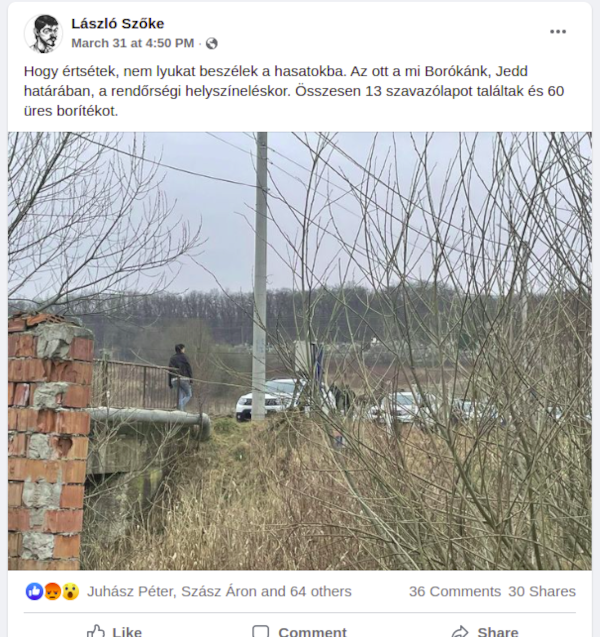
We contacted László Szőke, and he merely told us that the photo had been taken by a “local force”. We were unable to track down this photographer; we have no information about other photos of this event having been published.
Another recurring element of the “leftist provocation” narrative is that Transtelex “pre-wrote” this material, as there was a technical error in dating it when it was taken over to Telex’s editorial system, as the date had jumped back to a random day. According to the Transtelex official statement, the article could not possibly have been “prefabricated” on the 1st February as the order of the parties on the ballot papers was drawn on the 26th February, and the layout of the ballot papers was approved by the electoral committee on the 4th March.
Translation: Auguszta Szász. Original article here.
This article is part of our project aiming to monitor the 2022 parliamentary elections in Hungary. The project was funded in part by a grant from Investigative Journalism Europe (IJ4EU) and a grant from the United States Department of State. The opinions, findings and conclusions stated herein are those of the author[s] and do not necessarily reflect those of the funders.
